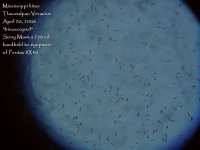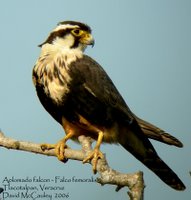
A story of an Aplomado falcon family in Veracruz.
Here goes.....I finally have some information and photos to share with you.
I live in Tlacotalpan Veracruz (the tropical lownds/wetlands of central Veracruz)
Here is a timeline to the Aplomado nesting activities.
First spotted
I spotted/digiscoped the female Aplomado falcon on April 3, 2006
Eggs laid
As close as I can tell the eggs were laid on or around April 6, 2006
First Aplomado "chick" hatched
On May 8, 2006 the first Aplomado falcon chick hatched
Nest discovered
the nest was discovered by Angel Montoya field biologist with the Aplomado Project -The Peregrine Fund and myself on April 24, 2006
Second Aplomado chick hatches
The second "chick" hatches May 11, 2006
in addition eggshell samples were taken from the nest and the nest was photographed by field biologists from The Peregrine Fund.
Observations begin
Since May 13, 2006 (time allowing) I try to get out to the site and observe the nest and Aplomado falcon behaviours twice a day, 1.5 hours in the morning and 1.5 hours in the afternoon.
Now for the photos. (just click on the highlighted links below to see photos) Note with regard to photos:
Unless otherwise noted ( see the Peregrine Fund photos),
these are my photos and may be copied for personal/educational use. Commercial use of my photos requires my permission.
David McCauley
hawkwatch@gmail.com
The power of "digiscoping". This PHOTO shows the magnification possibilities of "digiscoping" (a digital camera coupled with a spotting scope)
Without the "digiscoping" setup I would never attempt to photograph the nest.
Here are some images of the "lay of the land" and where I am in relation to the nest and observation perches of the Aplomados.
VIEW1
VIEW2
Some ID observations on the Aplomado falcons
Here are some photo charts that help show some of the field marks and differences between the male and female Aplomado falcons.
FEMALE APLOMADO
MALE APLOMADO
M/F Size Comparison
Meeting the Aplomados
Since I am in Mexico I have named the pair of Aplomados after the Maya dieties "Itzamna" and "Ixchel" SEE PHOTO
The NEST is either that of a Brown Jay, Roadside Hawk or possibly a Northern caracara, Aplomado falcons do not build nests but instead depend upon the nest building skills of others.
The nest photographed.
Here are photos of the nest with one "chick" hatched (approximately 3 days old) and the second "chick" is just breaking its way out of the egg. The reason for climbing up to the nest,(hence the photo) is a joint project of The Pergrine Fund and USGS with the end of collecting eggshell fragments and infertile eggs for testing of pesticide/herbicide levels. This is a good thing, field biology at work, a proactive approach to study unregulated pesticide use in Latin America. (DDT is still sold here in Mexico and is in no way regulated.) Hmm.
These photos were taken by a field biologist of The Peregrine Fund and have been used here with their permission. (These images are property of The Peregrine Fund and may NOT be copied or reproduced without their permission.) I am most grateful to The Peregrine Fund for the use of the photo on my weblog. Plese keep in mind that the photos taken is a result of a field study. Please, it should go without saying but- DO NOT CLIMB TREES OR USE MIRRORS ON POLES in order to photograph nesting chicks or egg clutches.
PHOTO 1
PHOTO2
PHOTO3
Ixchel and Itzamna on the nest.
IXCHEL (female)
ITZAMNA (male)
The feeding of the Aplomado Chicks.
PHOTO1
PHOTO2
PHOTO3
PHOTO4
PHOTO5
PHOTO6
So there you have the basics of the family of Aplomado falcons in Tlacotalpan Veracruz Mexico. I will as time allow continue to post photos of the progress of the young and share with you some of my field notes/observations.
The Aplomado falcon population was nearly eliminated in the US due to loss of habitat and pesticide contamination.
Thanks to the ongoing efforts of The Peregrine Fund with their Aplomado Falcon Project, the species in now being successfully re-introduced into its former breeding habitats.
I would encourage all who can, to actively support this ongoing project.
David McCauley
hawkwatch@gmail.com








































